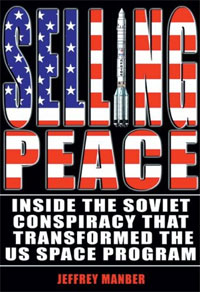Review: Selling Peaceby Jeff Foust
|
| Manber had to educate Energia about how a Western business operates, bringing copies of the Wall Street Journal to one meeting for a tutorial on the stock market. |
The struggle to win that license is recounted in the opening section of Selling Peace, Jeffrey Manber’s memoir of working with the Russians to commercialize their space program, and the opportunities and obstacles they encountered. At the time of the Payload Systems effort to fly their experiment to Mir, Manber was working at the Office of Space Commerce, a new organization within the Department of Commerce designed to promote commercial space efforts. Manber and his colleagues supported the initiative and helped push through the export control application (which, to keep it from setting off any red flags during the interagency review process, described the experiment as an effort to “conduct industrial research in a Soviet laboratory”). That export license was ultimately awarded, to the consternation of NASA and its Congressional supporters, who saw it as undercutting their efforts to develop Space Station Freedom.
In the early 1990s Russia’s NPO Energia (now RSC Energia) approached Manber about setting up a US office, which became Energia Ltd. For several years he worked to educate NASA and American aerospace companies about Energia’s capabilities, particularly as they were grappling with cost overruns on Freedom. At the same time he was also educating Energia’s officials, including general director Yuri Semenov, on how a Western business operates: he recalls one 1992 meeting at Energia’s headquarters outside Moscow where he brought along copies of the Wall Street Journal to provide a tutorial on the stock market. There were also battles with NASA, which preferred to work with the newly-formed, but relatively poor and powerless Russian Space Agency, than directly with Energia.
About half of the book is devoted to Manber’s most famous—or, perhaps, infamous—venture with the Russians: MirCorp. In the fall of 1999 a group led by multimillionaire Walt Anderson approached Manber with an audacious plan: to buy the Mir space station, which Russia had effectively abandoned to focus on the ISS. Buying the station outright wasn’t feasible, Manber advised, but after some discussion an alternative plan to lease the station from Energia emerged. Manber writes that he was reticent to take the job of CEO of MirCorp when Anderson offered it, unwilling at first to throw himself back into the “mess of cultural confusions” created by dealings between Americans and Russians. He was, though, convinced to accept it in part by Anderson saying that if he didn’t, “I would kick myself watching someone else attempt to create a commercial manned exploration company.”
| Selling Peace provides an enlightening and engaging look at the history of efforts to commercialize Russia’s space program from the viewpoint of someone at the heart of much of that effort. |
The history of MirCorp, and its ultimately unsuccessful attempt to commercialize Mir, has been chronicled elsewhere, including last year’s documentary Orphans of Apollo (see “Preview: Orphans of Apollo”, The Space Review, July 28, 2008). However, Manber goes into much greater detail about the trials and tribulations of the company and its efforts to win customers from his unique insider’s perspective. At MirCorp’s “apogee” in October 2000, he states, the company had identified $100 million in potential revenue, including not just Dennis Tito but filmmaker James Cameron and reality show producer Mark Burnett (who planned to film a reality TV show with the winner flying to Mir), as well as an unidentified ISS partner nation willing to fly its experiments on Mir. Funding problems and political intrigue within Russia doomed the company, though, and less than six months after that apogee Mir was deorbited over the South Pacific.
Selling Peace provides an enlightening and engaging look at the history of efforts to commercialize Russia’s space program from the viewpoint of someone at the heart of much of that effort. (The book could have been served by a final round of copyediting, given the number of minor typos in the book, but that’s a minor nit.) Today most people don’t think twice about Russian participation in commercial space ventures: International Launch Services (once a Russian-American joint venture, but now wholly owned by Russian company Khrunichev) routinely launches commercial satellites, and Energia has a stake in Sea Launch, the multinational venture that also launches commercial satellites. While plans to launch Tito to the ISS created an uproar in early 2001 (which Manber recounts near the end of the book), such “spaceflight participants” have become more routine. Even plans by Excalibur Almaz, a company based on the Isle of Man, to use Soviet-era Almaz hardware for commercial orbital human spaceflight, have done little more than raise an eyebrow or two. Selling Peace is a reminder of the long and difficult path, both in Russia and America, to make such ventures possible.
